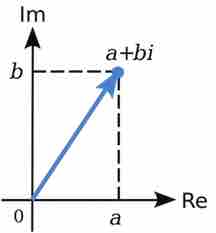Complex Conjugates
The complex conjugate (sometimes just called the conjugate) of a complex number
Thus, for example, the conjugate of
The symbol for the complex conjugate of
The Product of Two Conjugates
The product of two conjugates is always a real number. Note that:
This number has a geometric significance.

The length of a complex number
The length of the line segment from the origin to the point
The number
Or in other words:
The modulus symbol looks just like the absolute value symbol, which is okay because whenever
So the symbol is consistent with the use of the absolute value symbol.
Complex Roots Come in Conjugate Pairs
One important fact about conjugates is that whenever a complex number is a root of polynomial, its complex conjugate is a root as well. This can be seen in the quadratic formula whenever the discriminant
For example, consider the equation:
By the quadratic formula, the roots are
Simplifying gives the two complex numbers